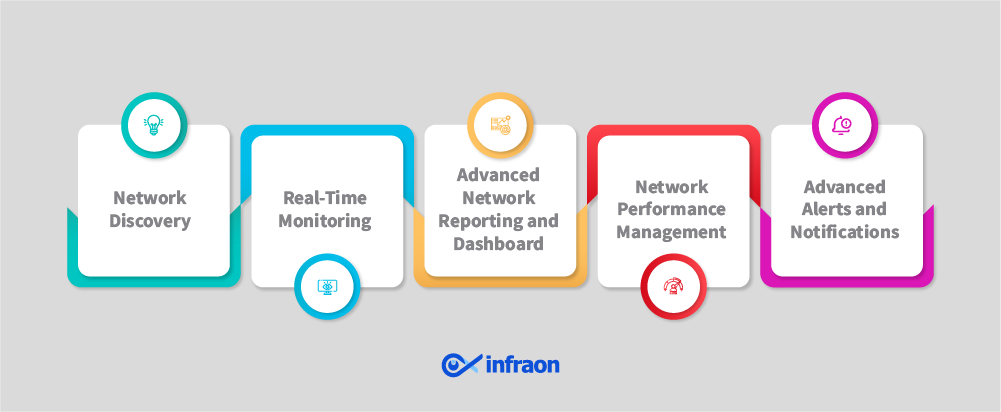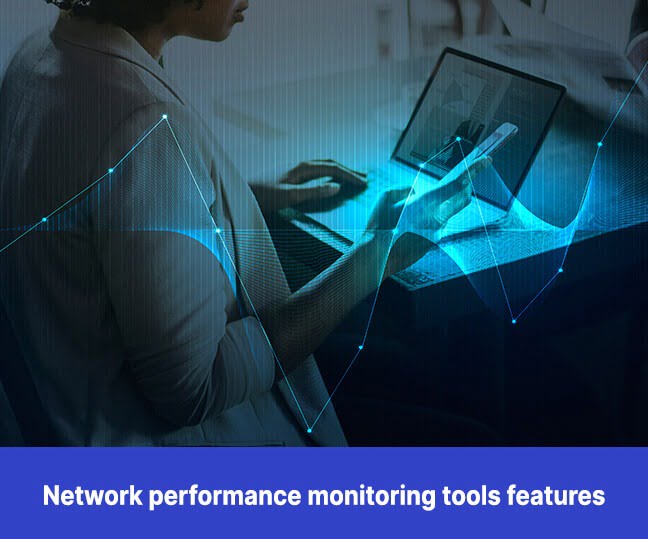Network infrastructure forms the backbone of any business, big or small. As networks become increasingly complex and critical for operations, the importance of robust network monitoring software has skyrocketed. Network Monitoring Software Tools (NMS) is a crucial tool for IT professionals to ensure their networks’ health, performance, and security. But with so many options available in the market, what features should you prioritize when selecting an NMS solution? Here, we’ll discuss the top five features to look for, drawing insights from a comprehensive solution in real-time network monitoring.
Related blog: Network capacity planning: Leveraging NMS for traffic optimization for ITES Companies
5 Key Features to Look for in Network Monitoring Software Tool
While network monitoring software offers numerous features, there are a few that organizations must look for, such as network discovery, real-time monitoring, advanced network reporting and dashboards, network performance management, and advanced alerts and notifications.

1. Network Discovery
Network discovery is the cornerstone of any efficient network monitoring tool. It is the ability to automatically identify and map all devices and connections within a network. This feature saves time and ensures that every component of your network is accounted for, including those that might have been overlooked or forgotten.
- Automated Inventory: Automatically keeps track of devices, saving considerable time and reducing the risk of human error.
- Dynamic Network Mapping: Offers a visual representation of the network, simplifying troubleshooting and understanding of the network structure.
- Early Detection of Unauthorized Devices: Helps identify potential security threats by detecting new and possibly unauthorized devices on the network.
2. Real-Time Monitoring
The ability to monitor network performance in real-time is a game-changer. IT professionals can see what’s happening on their network at any given moment, allowing for immediate response to issues as they arise.
- Instant Problem Identification: Quickly pinpoint the source of traffic bottlenecks or failing devices, etc.
- Bandwidth Monitoring: Helps in understanding bandwidth usage patterns and identifying potential overloads.
- Proactive Maintenance: Enables the IT team to address problems before they escalate, reducing downtime.
3. Advanced Network Reporting and Dashboard
A sophisticated network monitoring tool should offer comprehensive reporting capabilities and an intuitive dashboard, allowing for the easy interpretation of complex data and helping administrators make informed decisions.
- Customizable Reports: Tailored reports to meet the organization’s specific needs.
- Historical Data Analysis: Enables trend analysis and helps forecast future network needs.
- User-Friendly Dashboard: Provides a centralized view of network health, simplifying management and monitoring tasks.
4. Network Performance Management
Effective network performance management is crucial for ensuring that your network runs smoothly and meets the evolving demands of your organization. This includes tools for traffic analysis, Quality of Service (QoS) management, and optimization strategies.
- Traffic Analysis and QoS: Ensures that critical applications get the bandwidth they need, improving overall network efficiency.
- Capacity Planning: Helps in predicting future network requirements and guides infrastructure investments.
- Troubleshooting Tools: Assists in quickly resolving performance issues, reducing downtime, and improving user experience.
5. Advanced Alerts and Notifications
The final piece of the puzzle is a robust system for alerts and notifications. This feature ensures network administrators are immediately informed of any issues, allowing swift action to prevent or minimize disruptions.
- Immediate Incident Awareness: Receive alerts in real-time for quick response to network anomalies or failures.
- Customizable Alerts: Tailor alert conditions and thresholds to suit your network’s unique needs.
- Escalation Protocols: Ensures that critical alerts reach the right people in a timely manner, streamlining the resolution process.
The features outlined above may be considered the pillars of a robust network monitoring solution that can benefit an organization and ensure optimal performance, thereby supporting your organization’s broader objectives.
Benefits of Network Monitoring Software
- Improved Network Performance and Reliability: Network monitoring software continuously scans the network for issues, allowing for quick identification and proactive resolution of problems to ensure high network uptime, enhanced performance, and minimized disruptions.
- Time and Cost Efficiency: Automated monitoring saves time and resources and significantly reduces operational costs, as network issues can be resolved quickly, often before they impact users or require extensive repairs.
- Enhanced Security: Network monitoring tools can identify suspicious activities, potential breaches, and vulnerabilities. This capability is crucial for maintaining the security of sensitive data and ensuring compliance with various regulatory standards.
- Data Analysis and Reporting: These tools collect vast data about network performance, which helps identify trends, plan network expansions, or optimize current resources. Detailed reports can aid in strategic planning and decision-making.
- Improved User Experience:: By ensuring that the network runs smoothly and reliably, network monitoring contributes to a better user experience. This aspect is particularly important for service providers whose business depends on providing uninterrupted, high-quality network services.
- Automated Alerts and Notifications: The software can be configured to send automatic alerts and notifications about network status, unusual activities, or when predefined thresholds are exceeded, allowing IT staff to react promptly, often resolving issues before they affect users.
- Asset Management: Network monitoring software often includes tools for inventory management, helping businesses keep track of their hardware, software, and network assets. This is essential for budgeting, compliance, and planning purposes.
- Downtime Reduction: By rapidly identifying and addressing network issues, network monitoring software significantly reduces downtime, which can be costly for businesses in terms of lost productivity and revenue.
Related blog: A Closer Look into AI-Driven Anomaly Detection for Networks
Conclusion
Selecting the right NMS is a strategic decision that can profoundly impact your IT infrastructure. The five key features discussed above form the backbone of a robust monitoring solution. By prioritizing these features, IT professionals can troubleshoot issues more effectively and proactively manage network health. Ultimately, the right NMS solution is an indispensable asset in maintaining the integrity and performance of modern network infrastructures.



















